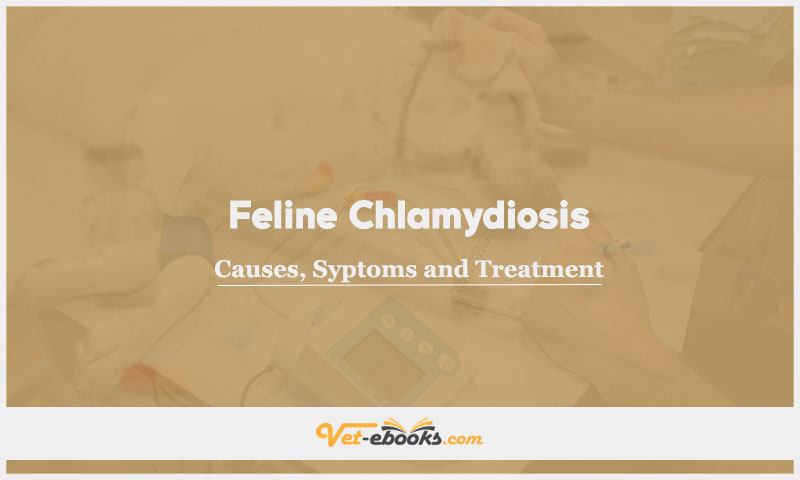Chlamydiosis In Feline: Causes, Symptoms and Treatment

Overview
Chlamydiosis is persistent infection of the feline respiratory system caused by an intracellular bacterium, featuring symptoms such as conjunctivitis, mild upper respiratory tract issues, and mild pneumonia.
Causes of Chlamydiosis In Feline
Causes
The primary culprit behind Chlamydiosis is Chlamydophila felis (formerly known as Chlamydia psittaci var. felis), an obligate intracellular Gram-negative bacterium. It spreads through close contact, aerosol transmission, or genital contact during childbirth.
Risk factors
- Co-infection with other respiratory agents like Feline Herpesvirus, Feline Calicivirus, Bordetella bronchiseptica, and Mycoplasma felis.
- Absence of immunization.
- Environments with multiple cats, particularly adoption centers and breeding establishments.
- Stress.
- Existence of carriers who do not show symptoms.
Pathogenesis of Chlamydiosis In Feline
- Chlamydia felis (formerly known as Chlamydia psittaci) is a bacterium that must reside inside host cells.
- It replicates in the mucous membranes of both the upper and lower respiratory tracts, resulting in a persistent presence as part of the normal flora. This presence can cause local irritation, leading to mild respiratory symptoms in the upper and lower airways.
- In ophthalmic cases, it often leads to chronic conjunctivitis, which can affect one or both eyes.
- Chlamydia felis can also establish colonies in the mucous membranes of the gastrointestinal tract (with or without noticeable symptoms) and the reproductive tract (without causing apparent signs).
- The occurrence of clinical disease is isporadic.
- Outbreaks of respiratory illness can occur, particularly in environments with multiple cats.
- The overall frequency of chronic infections is approximately 5% to 10%.
- The incubation period typically spans 7 to 10 days.
Symptoms (History & Physical Examination) of Chlamydiosis In Feline
History
- Cats younger than one year old typically display clinical symptoms.
- Carriers can be of any age.
- Historical signs include upper respiratory tract issues, including sneezing, watery eyes, occasional coughing, and, in some cases, difficulty breathing and reduced appetite, especially when co-infections with other respiratory agents are present.
- Commonly associated with feline conjunctivitis.
- Infections often go unnoticed, showing no apparent symptoms.
- Clinical disease typically arises in combination with other pathogens, such as feline herpesvirus (FHV) and feline coronavirus (FCV).
- Mainly characterized by symptoms like eye discharge and squinting.
- Mild upper respiratory infections may occur, occasionally accompanied by sneezing and discharge from the eyes and nose.
- Anorexia and lethargy may vary in severity.
Physical examination
- Conjunctivitis can affect one or both eyes, leading to swollen conjunctiva, squinting, redness in the conjunctiva and third eyelid, and a discharge that varies from clear to containing mucus and pus, without causing corneal inflammation.
- Mild discharge from the nose.
- Presence of a fever.
- Dyspnea and coughing are highly improbable; if pneumonia occurs, crackling sounds in the lungs (rales) may be heard.
Diagnosis of Chlamydiosis In Feline
1- From History and Physical Examination
2- Diagnostic Procedures
- PCR Testing: Preferred for its high sensitivity, involving a conjunctival swab placed in a sterile red top tube with sterile saline.
- Culture: Involves obtaining a conjunctival swab with vigorous exfoliation and submission on ice within 24 hours in specialized transport media like 2-sucrose-phosphate (2-SP).
- Conjunctival Cytology: May reveal characteristic intracytoplasmic basophilic inclusions when stained with Giemsa during the early stages of the disease.
- Serum Antibody Titers: Limited diagnostic value.
- ELISA Kits: Vary in sensitivity and specificity.
Pathological Findings
- Gross observations include chronic conjunctivitis with mucopurulent ocular discharge, minor rhinitis with nasal discharge, and sometimes lung changes indicative of pneumonitis.
- Histopathologic examination of the conjunctiva may reveal an initial intense infiltration of neutrophils, followed by an inflammatory response characterized by lymphocytes and plasma cells. Inclusions can be detected using special stains (these inclusions are not visible with routine H&E stains).
Blood Tests (CBC and Biochemistry)
- Blood tests may reveal an increase in white blood cell count (leukocytosis).
Imaging
- Thoracic radiographs can show lung tissue consolidation in cases of pneumonia.
3- Differential Diagnosis
- Feline herpesvirus infection has a brief incubation period of 4–5 days, resulting in rapid inflammation in both eyes, intense bouts of sneezing, and the development of ulcers on the cornea.
- Feline calicivirus infection also has a short incubation period of 3–5 days, causing ulcers in the mouth (stomatitis) and the possibility of lung inflammation (pneumonia).
- Feline reovirus typically results in a very mild upper respiratory tract infection with a brief incubation period and a short duration.
- Bronchial pneumonia, often triggered by bacteria like Bordetella bronchiseptica, can produce a distinct localized pattern in lung radiographs.
- Mycoplasma felis.
Treatment of Chlamydiosis In Feline
General
- Typically, outpatient care is sufficient.
- As needed, clean the eyes and nose with warm water or saline.
- Provide access to steam, such as in a bathroom, to help clear secretions.
- Offer soft and palatable foods; warming the food can enhance the cat’s sense of smell.
- In most cases, additional supportive therapy like fluids is not necessary, unless there are concurrent infections.
- Isolate affected cats to prevent contact with other cats.
- Restrict affected cats from going outdoors.
- Special diets may be used to entice cats with reduced appetite to start eating again.
Medications:
- Eye ointments are typically beneficial for treatment. Oxytetracycline applied 3-4 times a day for a span of 3 weeks is a commonly used option.
- However, ointments containing polymyxin may cause irritation in cats. As an alternative, erythromycin or fluoroquinolone ointments can be considered. It’s worth noting that the infection is resistant to bacitracin, neomycin, and gentamicin.
- For systemic antibiotics, tetracyclines are the preferred choice. Doxycycline, administered orally at a dosage of 10 mg per kilogram once a day or 5 mg per kilogram every 12 hours for a duration of 4 weeks, is recommended to prevent the recurrence of the infection.
- In the case of young kittens, an alternative option is amoxicillin-clavulanate, given at a dosage of 20-25 mg per kilogram orally every 12 hours.
Some Notes:
- Tetracyclines may cause teeth discoloration in growing teeth.
- Doxycycline has been linked to esophagitis and strictures in cats; it should be administered with food.
- In cases of colonies, it may be necessary to treat the entire group of cats.
- In breeding catteries with endemic Chlamydophila felis, it’s advisable to treat all cats with doxycycline for at least four weeks, followed by vaccination.
- Treatment might need to continue for up to six weeks.
- The prognosis for Chlamydophila felis infection tends to be chronic, lasting for several weeks or even months, unless effective antibiotic treatment is administered.
- Chlamydophila felis can infect humans, but the number of reported cases is limited, resulting in mild conjunctivitis transmitted from infected cats.
- The role of Chlamydophila felis as a pathogen during pregnancy remains unclear.
- The organism can colonize the reproductive mucosa, leading to severe conjunctivitis neonatorum in kittens infected at or shortly after birth.
Tip
Do You Want To Increase Your Veterinary Knowledge and Practical Skills?
You Can Now Browse and Download +3000 Books For Veterinary Professionals & Students Online.
Download Veterinary Books
















